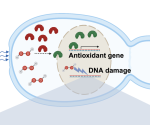Does neurodegeneration start when blood vessels are damaged?

Our brain depends on a finely tuned network of neurons, signals, and protective barriers to function seamlessly. This intricate setup underpins every thought, memory, and movement we make. But as we age, or under certain conditions, this system can break down.
Neurodegenerative diseases like Alzheimer’s, Parkinson’s, and amyotrophic lateral sclerosis (ALS) slowly damage neurons and over time these conditions lead to severe memory loss, confusion, and loss of independence. Despite decades of research, the precise mechanisms driving these diseases have remained elusive.
Shifting away from the traditional neuron-centric view of brain diseases, two studies published recently in Science Advances and Nature Neuroscience, offer a compelling new piece to this puzzle. The teams’ research reveals a startling possibility: what if the trouble begins long before neurons die?
The studies suggest that damage to the blood-brain barrier (BBB) may in fact be the first domino to fall in neurodegenerative diseases.

First line of defence
The BBB is one of the brain’s most critical protections. It is made up of tightly packed endothelial cells that line blood vessels in the brain. Their job is to gatekeep: letting in vital nutrients while keeping out toxins, pathogens, and harmful immune cells.
“Endothelial cells are the first cells exposed to what we eat, what infections we carry, or even the medications we take,” Ashok Cheemala, lead author of the Science Advances study, said. “If these cells become inflamed or damaged, the barrier becomes leaky. When that happens, harmful substances can slip into the brain and trigger inflammation.”
This inflammation, in turn, can lead to neuron death, which causes memory loss and cognitive decline — the hallmarks of diseases like Alzheimer’s and frontotemporal dementia (FTD).
Helpful and harmful
The TDP-43 protein regulates RNA and ensures proper gene expression inside cells in a process called splicing. Under healthy conditions, it is located in the nucleus of cells. But in people with neurodegenerative diseases, it goes rogue.
“If it accumulates in the cytoplasm, it starts to form toxic aggregates that can spread from one cell to another,” Cheemala said. While these aggregates have primarily been studied in neurons, researchers have been wondering whether endothelial cells that make up the BBB are also affected.
King’s College London neurologist Jemeen Sreedharan said, “TDP-43 is found in virtually every cell in the body, not just in the brain. It’s been detected in the skin, liver, kidneys, even reproductive organs. So its presence in endothelial cells isn’t surprising. What’s interesting is the idea that its dysfunction in these cells could kickstart the disease process.”

Leaky in the barrier
To investigate, the team used genetically modified mice carrying a disease-causing mutation in the Tardbp gene that encodes TDP-43. “Even a single point mutation in TDP-43 in endothelial cells was enough to cause BBB leakage, brain inflammation, and behavioural changes in mice,” Cheemala said. As they aged, these mice showed increased leakage of molecules from the bloodstream into the brain, evidence of a compromised barrier.
The researchers found that key proteins holding the BBB together, like claudin-5 and VE-cadherin, were lost, allowing molecules from the bloodstream to leak into brain tissue. These mice also displayed memory problems. The team also injected fluorescent dyes and tracked their penetration into the brain, analysing changes in the structure and protein composition of the BBB to verify their findings.
“This mutation is present from early development, even before birth,” Sreedharan said. “These mice don’t develop obvious brain disease but they do have vascular abnormalities. That points to blood vessel dysfunction as a possible early driver of neurodegeneration.”
The human connection
The team also analysed over 130,000 individual brain-cell nuclei from postmortem human brain samples from 92 donors aged 20-98, including both healthy individuals and those with certain neurodegenerative conditions. They profiled the RNA and nuclear proteins at the single-nucleus level and examined molecular changes in various brain cells. “We specifically looked at TDP-43 levels in the nuclei of endothelial cells. In patient samples, the nuclear TDP-43 was dramatically reduced compared to healthy controls,” Cheemala said.
The findings mirrored those of the mouse model. Loss of TDP-43 caused β-catenin to disintegrate, ramping up inflammatory signalling. The team also identified a specific group of damaged capillary cells that had low TDP-43 and high inflammation, suggesting they’d shifted from maintenance to damage mode.
Still, the human data came with caveats. “Post-mortem studies are limited by variability in tissue quality and timing,” Sreedharan said. “But combining those with controlled mouse models makes the case much stronger.”
“It’ll be important to see if this endothelial phenotype is specific to neurodegenerative diseases or a more general response to brain injury. Studying non-genetic conditions like multiple sclerosis or traumatic brain injury could help clarify this,” he added.

Early detection opportunity
The findings open a window for early diagnosis and prevention. “It’s compelling to think a disease we’ve long considered neuron-specific may actually start in the vasculature,” Sreedharan said.
The team is now working on potential blood-based biomarkers, especially proteins that are regulated by TDP-43 and may be secreted into the bloodstream when endothelial cells are affected.
“One candidate is HDGLF2, a protein that changes when TDP-43 function is lost. If we can detect that in blood, we may be able to identify the number of years an at-risk individual has before their symptoms appear, Cheemala said.
The researchers are also exploring whether exosomes — tiny particles released by cells, which may carry distinct protein signatures from damaged blood vessels — could serve as early indicators of disease. This could lead to non-invasive tests for diagnosing neurodegenerative diseases in their silent stages, long before symptoms appear and while interventions may still be effective.
Manjeera Gowravaram has a PhD in RNA biochemistry and works as a freelance science writer.
Published – May 25, 2025 05:00 am IST















